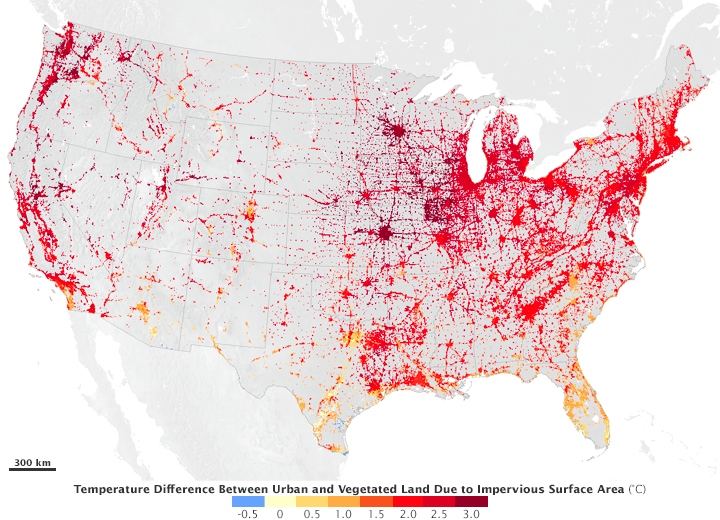 The amount of vegetation in a city is an important factor in the urban heat island, where temperatures in urban areas rise an average of 1 to 3°C due to the absorption of heat by asphalt, concrete, stone, steel, and other impervious surfaces. Vegetation helps cool these areas and a new study by NASA, shows how essential plant cover is. Researchers modeled urban areas and their surroundings, using data from multiple satellites including MODIS on-board both Terra and Aqua and Landsat 7’s Enhanced Thematic Mapper Plus (EMT+), finding that areas covered partly by impervious surfaces had an average summer temperature 1.9°C higher than surrounding rural areas. In winter, the temperature difference was 1.5 °C higher. Lahouri Bounoua, a researcher at Goddard Space Flight Center and lead author, along with his colleagues used the model environment to simulate what the temperature would be for a city if all the impervious surfaces were replaced with vegetation.
The amount of vegetation in a city is an important factor in the urban heat island, where temperatures in urban areas rise an average of 1 to 3°C due to the absorption of heat by asphalt, concrete, stone, steel, and other impervious surfaces. Vegetation helps cool these areas and a new study by NASA, shows how essential plant cover is. Researchers modeled urban areas and their surroundings, using data from multiple satellites including MODIS on-board both Terra and Aqua and Landsat 7’s Enhanced Thematic Mapper Plus (EMT+), finding that areas covered partly by impervious surfaces had an average summer temperature 1.9°C higher than surrounding rural areas. In winter, the temperature difference was 1.5 °C higher. Lahouri Bounoua, a researcher at Goddard Space Flight Center and lead author, along with his colleagues used the model environment to simulate what the temperature would be for a city if all the impervious surfaces were replaced with vegetation.
Full story on the Earth Observatory

